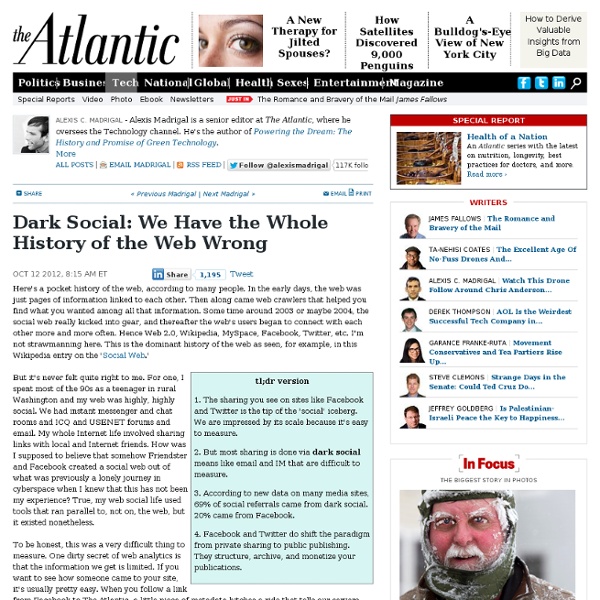Dark Social: We Have the Whole History of the Web Wrong - Alexis C. Madrigal

Social Networking and Ethics
First published Fri Aug 3, 2012 In the first decade of the 21st century, new media technologies for social networking such as Facebook, MySpace, Twitter and YouTube began to transform the social, political and informational practices of individuals and institutions across the globe, inviting a philosophical response from the community of applied ethicists and philosophers of technology. While this scholarly response continues to be challenged by the rapidly evolving nature of social networking technologies, the urgent need for attention to this phenomenon is underscored by the fact that it is reshaping how human beings initiate and/or maintain virtually every type of ethically significant social bond or role: friend-to-friend, parent-to-child, co-worker-to co-worker, employer-to-employee, teacher-to-student, neighbor-to-neighbor, seller-to-buyer, and doctor-to-patient, to offer just a partial list. Nor are the ethical implications of these technologies strictly interpersonal. 1. 2. 3.
Why Klout matters. A lot.
Yes, this is a real invitation. If you hate Klout … and you probably do … try to take a deep breath and read ahead with an open mind. Nothing seems to get rational people in a frenzy as much as Klout and its attempt to measure “influence.” Before I get into why, let’s knock a few obvious facts out of the way: Klout cannot measure every type of influence. Now, for a different perspective. Before the Internet, you had to actually accomplish something to be a celebrity. Even me. In my small world here in Knoxville, Tennessee, USA, I might influence my family, maybe some business colleagues, and that’s about it. Just a few years ago, there is no way you would have heard of Mark Schaefer. So even a nobody like me can become an Influencer. Content is power. The ability to create and move content is the absolute key to online influence. That’s what Klout is trying to do. So an important distinction is that if you’re not on the social web, you’re obviously not being measured.
A Social Publishing Model from Intel: “iQ”
inShare120 Guest post by Bryan Rhoads, global content strategy, Intel Today’s web is an endless 24/7 cycle fed by content and social actions. In this cycle, brands are realizing that content is currency and social actions are the transactions in this marketplace for eyeballs and attention. To remain relevant, not only do brands need to produce more interesting, useful and more timely content, they need to adapt to a new “social publishing model” to best feed the social graph and this hungry cycle. I’ve listed two ways below that our brand, Intel, is tackling this content and social publishing challenge. First, we built a new social publishing platform called “iQ” that we use to feed the graph and better integrate our owned and paid media strategies. Secondly, social publishing is a challenge for brands and businesses. At Intel, we are implementing a 3-tiered approach to content production (see “Social Content Tiers” diagram below). Follow @bryanrhoads on Twitter Tags:
Related:
Related:



